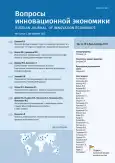Characteristics of the digital asset market evolution
- Authors: Ustinova O.E.1, Izzuka T.B.1, Milovidova S.N.1
-
Affiliations:
- The Financial University under the Government of the Russian Federation
- Issue: Vol 13, No 3 (2023)
- Pages: 1241-1252
- Section: Articles
- URL: https://journals.rcsi.science/2222-0372/article/view/146801
- DOI: https://doi.org/10.18334/vinec.13.3.119199
- ID: 146801
Cite item
Abstract
Keywords
About the authors
Olga Evgenevna Ustinova
The Financial University under the Government of the Russian Federation
Email: olga.e.ustinova@yandex.ru
доцент Департамента стратегического и инновационного развития Факультета «Высшая школа управления», кандидат экономических наук
Tatiana Borisovna Izzuka
The Financial University under the Government of the Russian Federation
Email: tbizzuka@fa.ru
доцент Департамента бизнес-аналитики Факультета налогов, аудита и бизнес-анализа, кандидат экономических наук
Svetlana Nikolaevna Milovidova
The Financial University under the Government of the Russian Federation
Email: snmilovidova@fa.ru
доцент Департамента бизнес-аналитики Факультета налогов, аудита и бизнес-анализа, кандидат экономических наук
References
- Акра. Бюллетень долгового рынка. [Электронный ресурс]. URL: https://acra-ratings.ru/research/2743/ (дата обращения: 05.09.2023).
- Аксенова Н.И., Спиридонова Е.В. Экономические отношения. , 2021. – 201-220 c.
- Горнин Э.Л., Принцев Р.А. Эмиссия и обращение криптовалюты: перспективы развития в России и КНР // Экономика, предпринимательство и право. – 2021. – № 5. – c. 1077-1088. – doi: 10.18334/epp.11.5.112072.
- Сенин А.C. Внедрение цифровых платформ управления базирующихся на технологии блокчейн // Экономика и социум: современные модели развития. – 2019. – № 2. – c. 167-176. – doi: 10.18334/ecsoc.9.2.40862.
- Adhami S., Giudici G., Martinazzi S. Why do businesses go crypto? An empirical analysis of initial coin offerings // Journal of Economics Business. – 2018. – № 100. – p. 64–75.
- Berentsen, Aleksander. Aleksander Berentsen Recommends ‘Bitcoin: A Peer-to-Peer Electronic Cash System’ by Satoshi Nakamoto. In 21st Century Economics. Edited by Bruno S. Frey and Christoph A. Schaltegger. Cham: Springer International Publishing. – 2019. pp. 7–8
- Blockchain.com. [Электронный ресурс]. URL: https://www.blockchain.com/ru/explorer/blocks/btc/0 (дата обращения: 05.09.2023).
- Charfeddine L., Benlagha N., Maouchi Y. Investigating the dynamic relationship between cryptocurrencies and conventional assets: Implications for financial investors // Economic Modelling. – 2020. – № 85. – p. 198–217.
- Chainalysis. [Электронный ресурс]. URL: https://www.chainalysis.com/blog/2022-cryptocurrency-predictions/ (дата обращения: 05.09.2023).
- European Banking Authority. (2014). EBA Opinion on ‘virtual currencies’ (S. 1–46). [Электронный ресурс]. URL: https://eba.europa.eu/documents/10180/657547/EBA-Op-2014-08+Opinion+on+Virtual+Currencies.pdf (дата обращения: 22.08.2023).
- Fisch C. Initial coin offerings (ICOs) to finance new ventures // Journal of Business Venturing. – 2019. – № 34(1). – p. 1–22.
- Glas T.N. Investments in cryptocurrencies: Handle with care! // Journal of Alternative Investments. – 2019. – № 22(1). – p. 96–113.
- Hassani, Hossein, Xu Huang, and Emmanuel Silva. Big-Crypto: Big Data, Blockchain and Cryptocurrency. Big Data and Cognitive Computing. – 2018. 2: 34
- International Token Standardization Association. (2019). [Электронный ресурс]. URL: www.itsa.global (дата обращения: 05.09.2023).
- Kim, M. S., Chung, J. Y. Sustainable growth and token economy design: The case of Steemit // Sustainability. – 2019. – № 11(1). – p. 167.
- Khelifa S.B., Guesmi K., Urom C. Exploring the relationship between cryptocurrencies and hedge funds during COVID-19 crisis // International Review of Financial Analysis. – 2021. – № 76. – p. 101777.
- Klein T., Thu H.P., Walther T. Bitcoin is not the new gold: A comparison of volatility, correlation, and portfolio performance // International Review of Financial Analysis. – 2018. – № 59. – p. 105-116.
- Kranz J., Nagel E., Yoo Y. Blockchain token sale // Business Information Systems Engineering. – 2019. – № 61(6). – p. 745–753.
- Kyriazis N. A Survey on Efficiency and Profitable Trading Opportunities in Cryptocurrency Markets // Journal of Risk and Financial Management. – 2019. – № 12. – p. 67.
- Lee J. Y. A decentralized token economy: How blockchain and cryptocurrency can revolutionize business // Business Horizons. – 2019. – № 62(6). – p. 773–784.
- Oliveira L., Zavolokina L., Bauer I., Schwabe G. To token or not to token: Tools for understanding blockchain tokens // International Conference of Information Systems: (ICIS 2018), San Francisco, USA. 2018.
- Schmandt-Besserat, D., Hallo, W. W. (1992). Before writing: Volume 1: From Counting to Cuneiform. University of Chicago Press
- Security Token Standard. (2019). Security token standard. [Электронный ресурс]. URL: https://thesecuritytokenstandard.org/ (дата обращения: 05.09.2023).
- Sifat I. On cryptocurrencies as an independent asset class: Long-horizon and COVID-19 pandemic era decoupling from global sentiments // Finance Research Letters. – 2021. – № 43. – p. 102013.
- Sharpe W. Asset allocation: Management style and performance measurement // Journal of Portfolio Management. – 1992. – № 18. – p. 7-19.
- Smales L.A. Bitcoin as a safe haven: Is it even worth considering? // Finance Research Letters. – 2019. – № 30. – p. 385–393.
- Statista. [Электронный ресурс]. URL: https://www.statista.com/outlook/dmo/fintech/digital-assets/united-states#revenue (дата обращения: 05.09.2023).
- Tasca, P. (2019). Token-based business models. In T. Lynn, J. G. Mooney, P. Rosati, M. Cummins (Eds.), Disrupting finance: FinTech and strategy in the 21st century (pp. 135–148). Springer International Publishing. https://ezpro.fa.ru:2117/10.1007/978-3-030-02330-0_9Return to ref 2019 in article
Supplementary files








